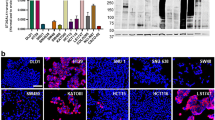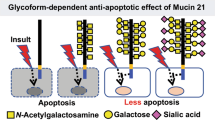Abstract
Numerous studies have shown that changes in the glycan structures of cells correlate with tumorigenesis, however, a casual link between the altered glycan structures and the abnormal GJIC in cancer cells is rarely studied. In this paper, we investigated the effects of sialic acid on the Cx43 gap junction functions, and clarified its potential mechanisms thereby. Sialidase significantly increased Cx43 gap junction functions in constructed Cx43-Hela cells along with down-regulation of cell surface sialic acid, which is dramatically reversed by sialidase inhibitor NeuAc2en. Further study indicated that sialidase failed to affect Cx43 at either protein or phosphorylation level, instead, it induced a considerable fraction of Triton X-100 insoluble, as compared with the untreated cells. We also found that sialidase treatment reduced the N-cadherin glycosylation and enhanced both Cx43–ZO-1 interaction and N-cadherin–ZO-1 association. Moreover, sialidase promoted the cell–cell adhesion with elevating N-cadherin binding to β-catenin, accompanied by increasing colocalization of Cx43 with microtubules at the cell periphery. Based on live cell microscopy, with the FARP technology in the Cx43-EGFP-Hela cells, we found that Cx43 in the plague recovered more quickly in sialidase treatment group, indicating that sialidase could promote the Cx43 traffic to the plague. Overall, these studies indicate cell surface sialic acid on cancer cells may suppress Cx43 gap junction functions via inhibiting Cx43 traffic to the plague involving in sialylated N-cadherin, a process that likely underlies the intimate association between abnormal GJIC and glycosylation on cancer development.







Similar content being viewed by others
References
Goodenough DA, Goliger JA, Paul DL (1996) Connexins, connexons and intercellular communication. Annu Rev Biochem 65:475–502
Saez JC, Berthoud VM, Branes MC, Martinez AD, Beyer EC (2003) Plasma membrane channels formed by connexins: their regulation and functions. Physiol Rev 83:1359–1400
Trosko JE, Ruch RJ (2002) Gap junctions as targets for cancer chemoprevention and chemotherapy. Curr Drug Targets 3:465–482
Mesnil M (2002) Connexins and cancer. Biol Cell 94:493–500
Trosko JE, Ruch RJ (1998) Cell-cell communication in carcinogenesis. Front Biosci 3:208–236
Zhao YY, Takahashi M, Gu JG et al (2008) Functional roles of N-glycans in cell signaling and cell adhesion in cancer. Cancer Sci 99:1304–1310
Malykh YN, Schauer R, Shaw L (2001) N-glycolylneuraminic acid in human tumours. Biochimie 83:623–634
Trosko JE, Chang CC, Wilson MR, Upham B, Hayashi T, Wade M (2000) Gap junctions and the regulation of cellular functions of stem cells during development and differentiation. Methods 20:245–264
Ishihara Y, Kamioka H, Honjo T, Ueda H, Takano-Yamamoto T, Yamashiro T (2008) Hormonal, pH, and calcium regulation of connexin 43-mediated dye transfer in osteocytes in chick calvaria. J Bone Miner Res 23:350–359
Shaw RM, Fay AJ, Puthenveedu MA, von Zastrow M, Jan YN, Jan LY (2007) Microtubule plus-end-tracking proteins target gap junctions directly from the cell interior to adherens junctions. Cell 128:547–560
Wang Y, Mehta PP, Rose B (1995) Inhibition of glycosylation induces formation of open connexin-43 cell-to-cell channels and phosphorylation and triton X-100 insolubility of connexin-43. J Biol Chem 270:26581–26585
Yazaki T, Miura M, Asou H, Kitamura K, Toya S, Uyemura K (1992) Glycopeptide of P0 protein inhibits homophilic cell adhesion. Competition assay with transformants and peptides. FEBS Lett 307:3661–3666
Alon R, Bayer EA, Wilchek M (1991) A coupled enzyme assay for measurement of sialidase activity. J Biochem Biophys Methods 22:23–33
Lampe PD, Lau AF (2000) Regulation of gap junctions by phosphorylation of connexins. Arch Biochem Biophys 384:205–215
Musil LS, Goodenough DA (1991) Biochemical analysis of connexin43 intracellular transport, phosphorylation, and assembly into gap junctional plaques. J Cell Biol 115:1357–1374
Ciołczyk-Wierzbicka D, Gil D, Hoja-Łukowicz D, Lityńska A, Laidler P (2002) Carbohydrate moieties of N-cadherin from human melanoma cell lines. Acta Biochim Pol 49:991–998
Balsamo J, Lilien J (1990) N-cadherin is stably associated with and is an acceptor for a cell surface N-acetylgalactosaminylphosphotransferase. J Biol Chem 265:2923–2928
Wei CJ, Francis R, Xu X, Lo CW (2005) Connexin43 associated with an N-cadherin-containing multiprotein complex is required for gap junction formation in NIH3T3 cells. J Biol Chem 280:19925–19936
Giepmans BN (2006) Role of connexin43-interacting proteins at gap junctions. Adv Cardiol 42:41–56
Itoh M, Nagafuchi A, Moroi S, Tsukita S (1997) Involvement of ZO-1 in cadherin-based cell adhesion through its direct binding to alpha catenin and actin filaments. J Cell Biol 138:181–192
Defamie N, Mograbi B, Roger C, Cronier L, Malassine A et al (2001) Disruption of gap junctional intercellular communication by lindane is associated with aberrant localization of connexin43 and zonula occludens-1 in 42GPA9 Sertoli cells. Carcinogenesis 22:1537–1542
Segretain D, Fiorini C, Decrouy X, Defamie N, Prat JR, Pointis G (2004) A proposed role for ZO-1 in targeting connexin 43 gap junctions to the endocytic pathway. Biochimie 86:241–244
Davis MA, Ireton RC (2003) Reynolds AB. A core function for p120-catenin in cadherin turnover. J Cell Biol 163:525–534
Reynolds AB, Carnahan RH (2004) Regulation of cadherin stability and turnover by p120ctn: implications in disease and cancer. Semin Cell Dev Biol 15:657–663
Wahl JK 3rd, Kim YJ, Cullen JM, Johnson KR, Wheelock MJ (2003) N-cadherin-catenin complexes form prior to cleavage of the proregion and transport to the plasma membrane. J Biol Chem 278:17269–17276
Dbouk HA, Mroue RM, El-Sabban ME, Talhouk RS (2009) Connexins: a myriad of functions extending beyond assembly of gap junction channels. Cell Commun Signal 7:4
Takahata M, Iwasaki N, Nakagawa H, Abe Y, Watanabe T, Ito M, Majima T, Minami A (2007) Sialylation of cell surface glycoconjugates is essential for osteoclastogenesis. Bone 41:77–86
Laird DW, Puranam KL, Revel JP (1991) Turnover and phosphorylation dynamics of connexin43 gap junction protein in cultured cardiac myocytes. Biochem J 273:67–72
Musil LS, Cunningham BA, Edelman GM, Goodenough DA (1990) Differential phosphorylation of the gap junction protein connexin43 in junctional communication-competent and -deficient cell lines. J Cell Biol 111:2077–2088
Hertzberg EL, Gilula NB (1979) Isolation and Characterization of Gap Junctions from Rat Liver. J Biol Chem 254:2138–2147
Giepmans BN, Moolenaar WH (1998) The gap junction protein connexin43 interacts with the second PDZ domain of the zona occludens-1 protein. Curr Biol 8:931–934
Hunter AW, Barker RJ, Zhu C, Gourdie RG (2005) Zonula occludens-1 alters connexin43 gap junction size and organization by influencing channel accretion. Mol Biol Cell 16:5686–5698
Acknowledgments
We thank Dr. Ben Giepmans for pEGFP-N1-hCx43 plasmid. This work was supported by National Basic Research Program Grant (2003CB716400) of China and Important Science & Technology Specific Projects of Shandong Province (2007GG2TC02048).
Author information
Authors and Affiliations
Corresponding author
Rights and permissions
About this article
Cite this article
Li, J., Cheng, L., Wang, Lj. et al. Cell surface sialic acid inhibits Cx43 gap junction functions in constructed Hela cancer cells involving in sialylated N-cadherin. Mol Cell Biochem 344, 241–251 (2010). https://doi.org/10.1007/s11010-010-0548-9
Received:
Accepted:
Published:
Issue Date:
DOI: https://doi.org/10.1007/s11010-010-0548-9




